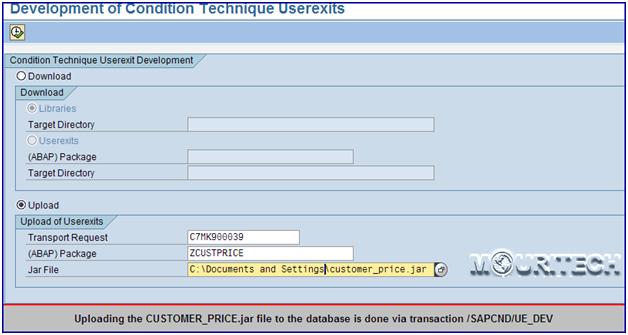
- SAP Community
- Products and Technology
- Additional Blogs by Members
- Pricing user exits in CRM
- Subscribe to RSS Feed
- Mark as New
- Mark as Read
- Bookmark
- Subscribe
- Printer Friendly Page
- Report Inappropriate Content
<body><p>In this blog, I will describe how simple R/3 routine written in JAVA for CRM3.x/4.0 and upgraded to CRM5.X/CRM7.0.</p><p>Most CRM projects replicate the R/3 pricing configuration (if not stand along CRM system) using CRM middleware, as orders will go through R/3 fulfillment process.</p><p>Once the download of customization and condition loads are done, R/3 custom pricing routines in VOFM needs to be re-written in JAVA.</p><p>As of SAP CRM 5.0, the previously separate Internet Pricing and Configurator (IPC) functionality for pricing has been integrated in the Virtual Machine Container (VMC) of SAP NetWeaver 7.0. With the move from IPCs server technology to the VMC, SAP also changed the technique of pricing user exit to allow customer to add the coding to the existing functionality in pricing.</p><p>While upgrading CRM 3.x and 4.0 to CRM5.x/CRM7.0, pricing user exits need to be upgraded to the new AP7.0 architecture. Until IPC4.0 all custom exits used to written in single class <IPC> \ipc\lib\userexits\PricingUserExits.java.</p><p>Details:
1. Following is the simple VOFM custom Requirement routine 600 in R/3 that need to rewrite in CRM using java.
FORM KOBED_600
sy-subrc = 4.
if komp-kposn ne 0.
check: komp-prsfd ca 'BX' and
komp-pstyv <> 'ZAAA' and komp-pstyv <> 'ZBBB' .
check: komp-kznep = space.
endif.
sy-subrc = 0.
ENDFORM.
FORM KOBEV_600.
2. For CRM3.X/4.0:Corresponding JAVA code implemented in method checkRequirement of PricingUserExits class .
public boolean checkRequirement(IConditionFindingManagerUserExit item,
IStep step,
int reqNo) {
IPricingItemUserExit pricingItem = (IPricingItemUserExit) item;
IPricingDocumentUserExit pricingDocument = pricingItem.getUserExitDocument();
IMessageObjMgr messageManager = pricingDocument.getMessageManager();
String language = pricingDocument.getLanguage();
switch (reqNo) {
case 600: String itemId = prCond.getItemId( );
if(itemId.equalsIgnoreCase("0"))
{
try {
if ((item.getItemAttributeValue(PricingConstants.AttributeNames.pricingIndicator).equals("X"))
&& (item.getItemAttributeValue("ITEM_TYPE").equals("ZAAA"))&& (item.getItemAttributeValue("ITEM_TYPE").equals("ZBBB")))
{
return true;
}
else
return false;
}
catch (UnsuppliedAttributeException e)
{
throw new SXERuntimeException(messageManager.getMessage(language, PricingConstants.PRICING_MESSAGE_AREA_NEW, 164, new Integer(reqNo).toString(), e.getMessage()));
}
}
return false;
3. For CRM5.X/7.0: As of AP700 each user exit formula is implemented in a separate java class which must be registered in the system separately.
a)Create separate Java class for 600 routine which inherit from relevant adapter class.
package com.mouritech.pricing.userexits;
import com.sap.spe.condmgnt.finding.userexit.RequirementAdapter;
import com.sap.spe.base.logging.UserexitLogger;
import com.sap.spe.condmgnt.customizing.IAccess;
import com.sap.spe.condmgnt.customizing.IStep;
import com.sap.spe.condmgnt.finding.userexit.IConditionFindingManagerUserExit;
public class ZNotCategory extends RequirementAdapter {
private static UserexitLogger uelogger = new UserexitLogger(ZNotCategory.class);
public boolean checkRequirement(IConditionFindingManagerUserExit item, IStep step, IAccess access) {
String strValue = item.getAttributeValue("ITEM_TYPE");
String priceIndicator = item.getAttributeValue("PRICING_INDICATOR");
if (priceIndicator.equals("X") && !strValue.equals("ZAAA") && !strValue.equals("ZBBB")) {
uelogger.writeLogDebug("Item category NOT equals ZAAA and ZBBB - "strValue);</p><p> return true;</p><p> }</p><p> uelogger.writeLogError("Item category equals "strValue);
return false;
}
}
b).Create the jar file using Eclipse or NWDS with above file and upload it to VMC using transaction /SAPCND/UE_DEV. It requires ABAP package and workbench request to upload.

c). Using transaction SM53(VMC admin),you can browse through the uploaded user exit classes.

d).Using transaction /n/SAPCND/UEASS ,register the implementation under REQ user exit type.In the field user exit class ,write fully qualified class name .

e). Maintain the attributes that we used in the code to implementation.

f). Assign the formula number to user exit implementation and also map relevant attributes to pricing catalog fields.
- Advance Return Management complete configuration(SAP ARM) in Enterprise Resource Planning Blogs by Members
- Print customer specific inspection plan results on Outbound Certificate of Analysis in SAP QM in Enterprise Resource Planning Q&A
- SAP Commerce Cloud Q1 ‘24 Release Highlights in CRM and CX Blogs by SAP
- Futuristic Aerospace or Defense BTP Data Mesh Layer using Collibra, Next Labs ABAC/DAM, IAG and GRC in Enterprise Resource Planning Blogs by Members
- Pricing - Volume discount by item group total in Enterprise Resource Planning Q&A